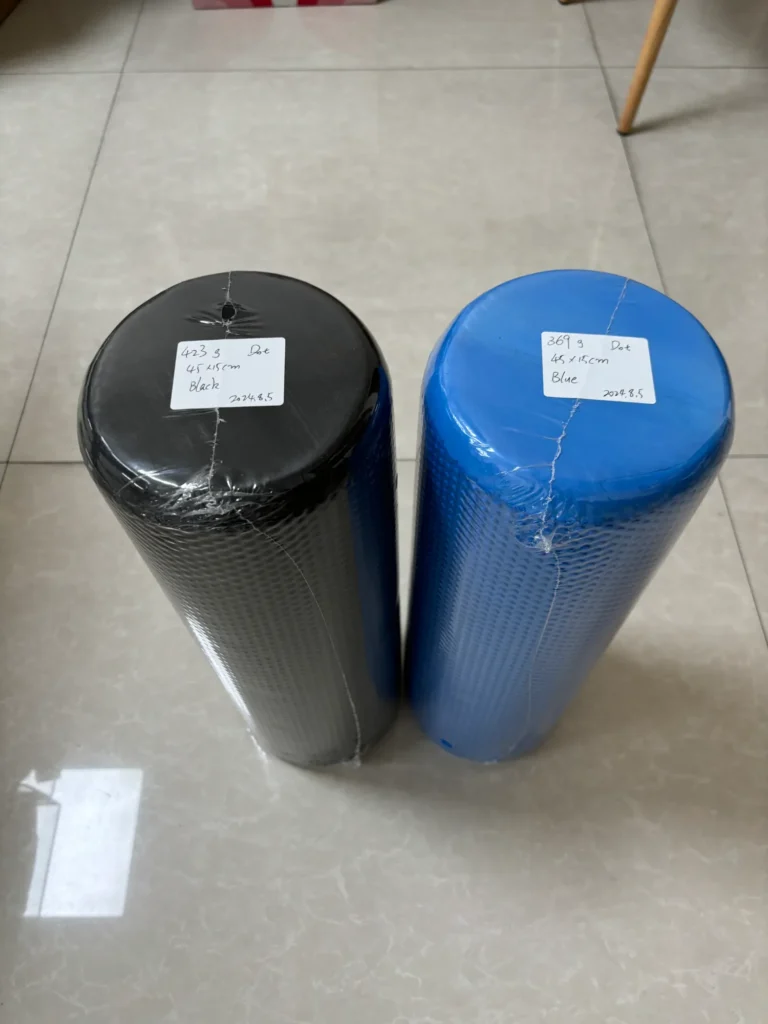When it comes to fitness and muscle recovery, solid foam rollers are a staple in many routines. These versatile tools help in relieving muscle tension, improving flexibility, and aiding in post-workout recovery. But have you ever wondered what solid foam rollers are made of? Let’s dive into the composition of these essential fitness tools, explore why PE foam is the primary material used, and understand the role of EVA in enhancing foam rollers.
The Composition of Solid Foam Rollers
Solid foam rollers, often referred to as solid EVA yoga rollers, muscle relaxation rollers, or massage rollers, are primarily constructed from foam materials. The most common material used in their production is PE (polyethylene) foam. In some cases, EVA (ethylene-vinyl acetate) is added to the mix to improve performance.
Why PE Foam is the Primary Material
Durability and Density
PE foam is favored in the construction of solid foam rollers due to its durability and density. These properties make PE foam rollers resilient, able to withstand repeated use without losing their shape or effectiveness. The density of PE foam provides the necessary firmness to effectively massage and relax tight muscles, making it a preferred choice for both beginners and seasoned athletes.
Cost-Effectiveness
Another reason PE foam is widely used is its cost-effectiveness. PE foam is relatively inexpensive to produce, making foam rollers accessible to a broad range of consumers. This affordability does not compromise the quality, ensuring that users receive a reliable and effective tool for muscle recovery and relaxation.
Lightweight and Portable
PE foam rollers are lightweight, which adds to their portability. Users can easily carry them to the gym, yoga class, or even when traveling. This convenience ensures that individuals can maintain their recovery routines wherever they go.
The Role of EVA in Enhancing Foam Rollers
Improved Flexibility and Cushioning
While PE foam provides the necessary firmness and durability, adding EVA foam enhances the flexibility and cushioning of the roller. EVA is known for its rubber-like softness and flexibility, which helps in creating a more comfortable and versatile foam roller. This combination of materials allows the foam roller to offer both firmness and a bit of give, catering to a wider range of preferences and needs.
Enhanced Performance
The addition of EVA to PE foam rollers improves their overall performance. EVA’s elasticity helps in distributing pressure more evenly across the roller’s surface, making the massage more effective and comfortable. This enhancement is particularly beneficial for individuals who need a gentler yet still effective massage experience.
Versatility
Foam rollers with EVA added to the PE base are versatile and can be used for various purposes, from deep tissue massage to gentle muscle relaxation. This versatility makes them suitable for different fitness levels and recovery needs, ensuring that users get the most out of their foam roller.
Conclusion
Solid foam rollers are indispensable tools for muscle recovery and relaxation, and understanding their composition can help users make informed choices. PE foam is the primary material used due to its durability, cost-effectiveness, and portability. However, the addition of EVA enhances the performance, flexibility, and cushioning of the rollers, making them even more effective and versatile. Whether you’re looking for a firm massage or a gentler touch, solid foam rollers made from PE and EVA offer the perfect solution for your recovery needs.
FAQ
1. What are solid foam rollers made of?
Solid foam rollers are primarily made from PE (polyethylene) foam, with some including EVA (ethylene-vinyl acetate) to enhance their performance.
2. Why is PE foam used in foam rollers?
PE foam is used for its durability, density, cost-effectiveness, and lightweight properties, making it an ideal material for foam rollers.
3. How does EVA enhance foam rollers?
EVA adds flexibility and cushioning, improves overall performance, and provides a more comfortable and versatile foam rolling experience.
4. Are foam rollers with EVA more expensive?
While EVA-enhanced foam rollers may be slightly more expensive due to the added material, they offer improved performance and comfort, making them worth the investment.
5. Can foam rollers be used for different fitness levels?
Yes, foam rollers made from PE and EVA are versatile and suitable for various fitness levels and recovery needs, from deep tissue massage to gentle muscle relaxation.


Pingback: Understanding Solid Foam Rollers: What Are They Made Of? - WELLE Trade